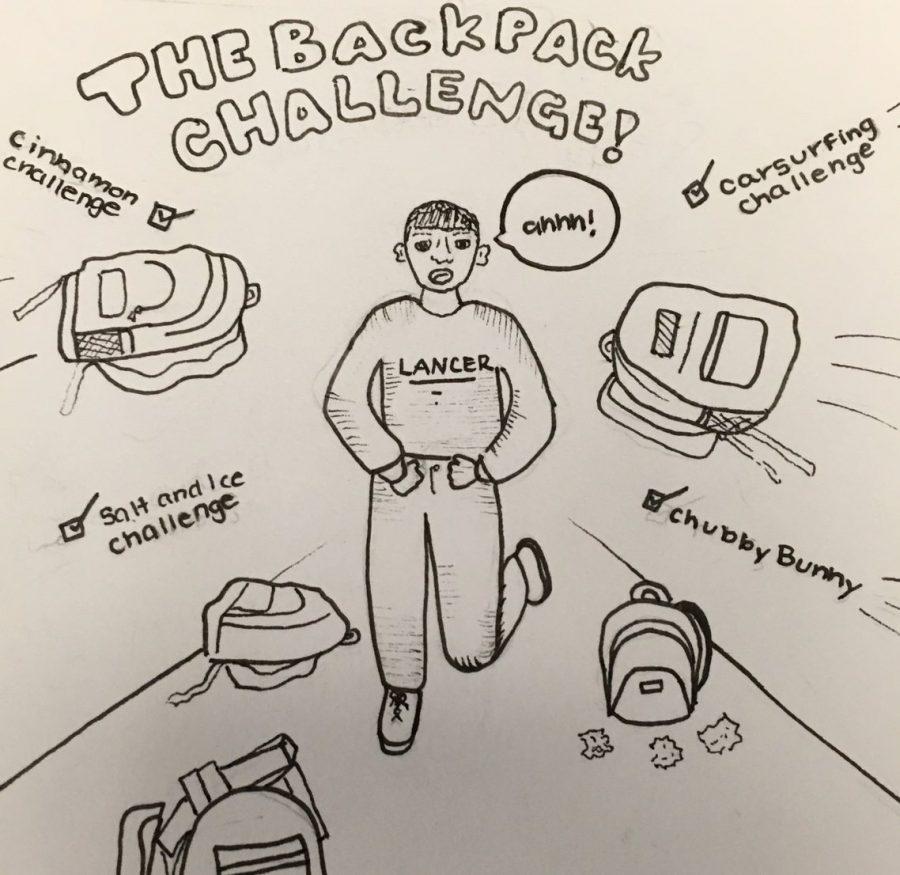Get off the bandwagon: Throw the “backpack challenge” away
February 22, 2017
Remember the cinnamon challenge in 2011-2012? We tried to eat a spoonful of throat-drying oxygen-impairing cinnamon with no water. We all did it (I certainly did), and we all laughed as our peers choked and coughed. Even after 222 teens had to be rushed to the hospital over the course of 2012 and four-year-old Matthew Radar was pronounced dead from inhaling cinnamon, some of us were still laughing.
With social media, the challenges have more continued to grow more bizarre and, in many cases, more dangerous. The condom challenge, ghost pepper challenge, and the car surfing challenge have led to hospitalizations and even deaths.
The newest of these high-risk challenges is the backpack challenge. The challenge involves a person being surrounded on either side by people with obscenely full backpacks who then throw their packs at the challenger until the victim runs the gauntlet or falls to the ground.
The most popular video of this challenge shows a 14-year-old boy who has to be hospitalized. Fun, right?
Whether it’s juggling knives or drinking vinegar, these challenges all have one thing in common: no one performs them alone. Completing the challenges has been equated with popularity and acceptance. They are proof of our reliance on community and the lengths we are willing to go to be part of the “in-crowd.”
Our willingness to perform risky and potentially fatal tasks isn’t a new development. Throughout all societies, including Native American tribes, African and Middle Eastern clans, and ancient Mediterranean groups, carving symbols in one’s skin was a common system of initiation, proving loyalty to the group.
These aspects of ancient cultures continue in our modern world through the dangerous challenges. While we may not be carving our clan symbols into our skin, millions of teens and young adults are more than willing to almost suffocate, choke, or be repeatedly beaten for the sake of proving their worth. Just think of the “hazing” commonly done to fraternity or sorority pledges. Almost all U.S. states have gone so far as to outlaw this behavior.
As the old saying goes: “If all your friends jumped off a bridge, would you jump, too?” Human psychology suggests that yes, we would jump too.
People still in their developmental phase, specifically teens and young adults, are gain-oriented. A study conducted by the University of Pittsburgh determined that adolescent brains display far greater activity when presented with reward-based challenges. Adult brains react with an even mix of excitement and caution. Adolescents focus on the gain while adults evaluate the loss.
It’s more difficult for teens to consider the consequences of their actions because of their brain chemistry. They rarely pause to think about risk. Thus, it’s easier for teens to fall prey to challenge crazes.
It takes a much stronger individual to say “no” to these crowd favorites.
I’ll be the first to admit that crazy activities like sky-diving and bungee jumping are ridiculously fun. I’ve leaped from rooftops. I’ve climbed mountains without a rope and harness; I understand the thrill and adrenaline that comes with defying death.
However, these challenges that dominate social media aren’t the same. This isn’t thrill-seeking. It’s sheer idiocy.
Even in ancient societies, honor was earned through strength, not stupidity. How can we judge the honorable deaths of samurai for their masters when we put ourselves in potentially fatal positions for the sake of a re-tweet?
Don’t be the next casualty for the sake of a snapchat about your strength or status because you had backpacks thrown at you.












